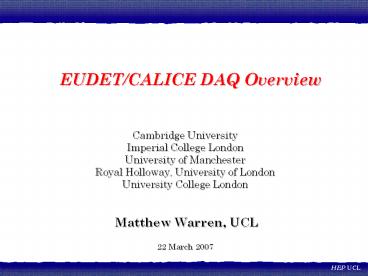Cambridge University - PowerPoint PPT Presentation
Title:
Cambridge University
Description:
EUDET/CALICE DAQ Overview Cambridge University Imperial College London University of Manchester Royal Holloway, University of London University College London – PowerPoint PPT presentation
Number of Views:534
Avg rating:3.0/5.0
Title: Cambridge University
1
EUDET/CALICE DAQ Overview
- Cambridge University
- Imperial College London
- University of Manchester
- Royal Holloway, University of London
- University College London
- Matthew Warren, UCL
- 22 March 2007
2
Ideal DAQ Structural Overview
ASICs
ASICs
ASICs
- Detector ASICs on e.g. ECAL slab
- Front-End (FE)
- FE-Interface (DIF) Detector specific
- FE Link/Data Aggregator (LDA) Generic
- Data-link (FE to Off-Detector Receiver)
- CCC-link (ClockControlConfig to FE)
- DAQ PC
- Off-Detector Receiver/s (ODR)
- Drives CCC-link
- Data Store
DIF
DIF
DIF
FE
LDA
Data-link
CCC-link
PC/s
ODR
Store
3
FE Structure Detail
- We have 2 types of detector to readout.
- Divide the FE into a 2 part, tiered system
- 1) Detector Interface module (DIF)
- Detector specific interface
- Includes power connectors
- Local systems (e.g. stand-alone clock)
- Debug connectors
- 2) Link/Data Aggregator module
- (LDA)
- Collects data from many DIFs
- Drives data Off detector link
- Receives and distributes CC
- FPGA Development board
- BUT
- We would might like to read-out slabs
individually first
ECAL Slab
ECAL Slab
HCAL Layer
HCAL Layer
ECAL DIF
HCAL DIF
HCAL DIF
ECAL DIF
Link/ Data Aggregator
Link/ Data Aggregator
CC Fanout
PC
PC
4
Data-link (CCC)
- Use most common networking fibre-optics
- Multimode with LC connectors
- SFP (mini-GBIC) interfaces
- 1Gbit rate (maybe tuned to multiple of machine
freq.) - Ethernet
- Control up-link NOT via fibre, initially.
5
Off-Detector Receiver (ODR)
- PCI Express Card
- Virtex 4, FX100 FPGA (big!)
- Hosts opto-links
- 2xSFP, 2xHSSDC2 on board
- Source of CC (Control link)
- Initially copper (LVDS)
- Later fibre
- Will use external clock and sync signals for
multi-board synchronous operation
6
ODR(2) - Status
- Firmware AND software well underway
- PCIe interface DONE
- Register read/write DONE
- DMA access DONE
- Ethernet Interface
- IN-PROGRESS
- DDR2 Interface IN-PROGRESS
- Linux driver DONE
- Optimised Disk Store
- IN-PROGRESS
- Manager Software
- IN-PROGRESS
- Performance profiling
- IN-PROGRESS
- Clock and Control Uplink
- NOT-STARTED
Ethernet Interface
DDR2 Interface
Internal RAM
Test Data Gen
Arbiter
Control/ Status Reg. Block
PCIe Interface
Firmware
Driver
Manager
Software
7
UK Read-out work (ECAL FE)
ECAL Slab
- Detector Interface (Cam, IC)
- Spec hardware
- DIF to Link/Data Aggregator (Cam/Man)
- Spec hardware
- Data aggregate, format (Man)
- Hardware firmware
- LDA to ODR opto-link (Man, UCL)
- Hardware firmware
- ODR (RHUL, UCL, Cam)
- firmware
- ODR to disk (RHUL)
- Driver software
- Local Software DAQ (RHUL)
- Full blown Software DAQ (RHUL, UCL, IC)
DIF
LDA
Opto
PC
ODR
Opto
Driver
8
Clock Control, Integration
- Keep it simple!
- -System synchronising signals distributed
- All data tagged with common timestamp
Clock Control (Train-start, Sync)
Slave out
Master In
Slab
LDA
Slab
PC
Slab
Fanout (TLU?)
ODR
Config
ODR
Slab
PC
LDA
Slab
ODR
Slab
Config
ODR
9
TLU Requirements
- Lets assume 32 Slabs.
- Each Slab needs Clk Train, (Trigger?)
- But could use LDA here. At 8 slabs/LDA 4 LDAs
- With minimum 1 LDA/ODR 4 ODRs
- Each ODR needs same Fast Control(data)
- 4 Signals Clock, Train, Trigger, Control
- Fanout of 32 slabs 4 LDA 4 ODE 40,
- OR more likely 4 LDA 4 ODR 8.
- TLU acts as Master or Slave for signalling
- TLU generates signals stand-alone
- We presume to use LVDS everywhere.
- ?? Do we try to use the TLU for fanout, or just
as a machine interface?
10
- Extra
- Optical Switch
11
Optical (Layer-1) Switching
- Part of the UK CALICE is to evaluate the use of a
layer-1 switch. - 1) DAQ PC failover - Redirect data to spare
unused DAQ PC on the fly - 2) Router - Can change data destination per
bunch-train. - Regulate load by sending data directly to free
resources - 3) Programmable optical patch panel (large
installation) - Manufacturers offering similar products, in same
price range e.g. Glimmerglass, Polatis -
difficult to differentiate between them - Decided on Polatis
- can switch dark fibre (i.e. not MEMS based)
- Multimode fibre capable
- Fastest switching time (20ms)
- 16x16 array with 50µm multimode LC connectors















![Barkatullah University - [BU], Bhopal PowerPoint PPT Presentation](https://s3.amazonaws.com/images.powershow.com/9665873.th0.jpg?_=20210928011)















